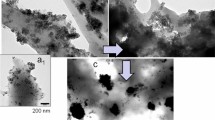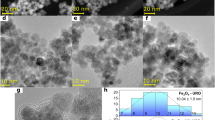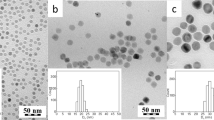Abstract
Commercially available Resovist is a superparamagnetic iron oxide used as a magnetic resonance imaging contrast agent. In this study, pH- and thermoresponsive poly(N,N-dimethylaminoethyl methacrylate) (PDMAEMA) was grafted onto the surface of Resovist (PDMA@Rv) via atom transfer radical polymerization. The zeta potential of PDMA@Rv was positive at pH values lower than the acid dissociation constant (pKa = 6.2) of the grafted PDMAEMA because of the protonation of the pendant tertiary amino groups. At pH 5.4, PDMAEMA became hydrophilic, and the size of PDMA@Rv remained constant, irrespective of temperature. Above pH 7, the zeta potential showed a negative value because of the deprotonation of the pendant tertiary amino groups in the grafted PDMAEMA chains. PDMA@Rv formed aggregates and showed lower critical solution temperature behavior above pH 7. The phase transition temperature (Tp), which is defined as the temperature at which the particle size began to increase during the heating process, was 61.5 °C for PDMA@Rv at pH 7.4. PDMA@Rv contained a larger number of core particles of iron oxide than Resovist, which reduced the initial magnetic susceptibility due to the interaction of the core magnetic particles inside PDMA@Rv.
This is a preview of subscription content, access via your institution
Access options
Subscribe to this journal
Receive 12 print issues and online access
$259.00 per year
only $21.58 per issue
Buy this article
- Purchase on Springer Link
- Instant access to full article PDF
Prices may be subject to local taxes which are calculated during checkout








Similar content being viewed by others
References
Long NV, Thi CM, Yong Y, Cao Y, Wu H, Nogami M. Synthesis and characterization of fe-based metal and oxide based nanoparticles: discoveries and research highlights of potential applications in biology and medicine. Recent Pat Nanotechnol. 2014;8:52–61.
Ruiz-Molina D, Novio F, Roscini C. Bio- and bioinspired nanomaterials. Wiley-VCH. 2014:9;229–53.
Dewey W, Hopwood L, Sapareto S, Gerweck L. Cellular responses to combinations of hyperthermia and radiation. Radiology. 1977;123:463–74.
Saito H, Mitobe K, Minamiya Y. Medical application of magnetic materials for cancer therapy. Drug Deliv Syst. 2014;29:304–14.
Ito A, Shinkai M, Honda H, Kobayashi T. Medical application of functionalized magnetic nanoparticles. J Biosci Bioeng. 2005;100:1–11.
Shubayev VI, Pisanic TR, Jin S. Magnetic nanoparticles for theragnostics. Adv Drug Deliv Rev. 2009;61:467–77.
Tartaj P, del Puerto Morales M, Veintemillas-Verdaguer S, González-Carreño T, Serna CJ. The preparation of magnetic nanoparticles for applications in biomedicine. J Phys D Appl Phys. 2003;36:R182.
Santhosh B, Ulrih NP. Multifunctional superparamagnetic iron oxide nanoparticles: promising tools in cancer theranostics. Cancer Lett. 2013;336:8–17.
Huang G, Chen H, Dong Y, Luo X, Yu H, Moore Z, et al. Superparamagnetic iron oxide nanoparticles: amplifying ROS stress to improve anticancer drug efficacy. Theranostics. 2013;3:116–26.
Singh A, Sahoo SK. Magnetic nanoparticles: a novel platform for cancer theranostics. Drug Disco Today. 2014;19:474–81.
Chen J, Shi M, Liu P, Ko A, Zhong W, Liao W, et al. Reducible polyamidoamine-magnetic iron oxide self-assembled nanoparticles for doxorubicin delivery. Biomaterials. 2014;35:1240–48.
Fang C, Kievit FM, Veiseh O, Stephen ZR, Wang T, Lee D, et al. Fabrication of magnetic nanoparticles with controllable drug loading and release through a simple assembly approach. J Controlled Rel. 2012;162:233–41.
Karimzadeh I, Aghazadeh M, Ganjali MR, Norouzi P, Shirvani-Arani S, Doroudi T, et al. A novel method for preparation of bare and poly(vinylpyrrolidone) coated superparamagnetic iron oxide nanoparticles for biomedical applications. Mater Lett 2016;179:5–8.
Liu Y, Feng G, Guo X, Wu Z, Chen Y, Xiang W, et al. Employing MnO as multifunctional polysulfide reservoirs for enhanced-performance Li-S batteries. J Alloy Compd 2018;748:100–10.
Zhu K, Deng Z, Liu G, Hu J, Liu S. Photoregulated cross-linking of superparamagnetic iron oxide nanoparticle (SPION) loaded hybrid nanovectors with synergistic drug release and magnetic resonance (MR) imaging enhancement. Macromolecules. 2017;50:1113–25.
Li L, Shang L, Chen K, Wang Q, Luo J, Zhou Q, et al. Redox-sensitive core cross-linked polyethylene glycol-polypeptide hybrid micelles for anticancer drug delivery. J Nanosci Nanotechnol 2017;17:4532–41.
Yar Y, Khodadust R, Akkoc Y, Utkur M, Saritas EU, Gozuacik D, et al. Development of tailored SPION-PNIPAM nanoparticles by ATRP for dually responsive doxorubicin delivery and MR imaging. J Mater Chem B. 2018;6:289–300.
Patra S, Roy E, Karfa P, Kumar S, Madhuri R, Sharma PK. Dual-responsive polymer coated superparamagnetic nanoparticle for targeted drug delivery and hyperthermia treatment. ACS Appl Mater Interfaces. 2015;7:9235–46.
Li L, Zhang C, Zhang R, Xu Z, Xu Z. Multifunctional magnetized porous silica covered with Poly(2-dimethylaminoethyl methacrylate) for pH controllable drug release and magnetic resonance imaging. ACS Appl Nano Mater. 2018;1:5027–34.
Majewski AP, Schallon A, Jérôme V, Freitag R, Müller AHE, Schmalz H. Dual-responsive magnetic core–shell nanoparticles for nonviral gene delivery and cell separation. Biomacromolecules. 2012;13:857–66.
Stark WJ, Stoessel PR, Wohlleben W, Hafner A. Industrial applications of nanoparticles. Chem Soc Rev. 2015;44:5793–805.
Reimer P, Schuierer G, Balzer T, Peters PE. Application of a superparamagnetic iron oxide (Resovist) for MR imaging of human cerebral blood volume. Magn Reson Med. 1995;34:694–7.
Reimer P, Balzer T. Ferucarbotran (Resovist): a new clinically approved RES-specific contrast agent for contrast-enhanced MRI of the liver: properties, clinical development, and applications. Eur Radiol. 2003;13:1266–76.
Sato I, Umemura M, Mitsudo K, Kioi M, Nakashima H, Iwai T, et al. Hyperthermia generated with ferucarbotran (Resovist®) in an alternating magnetic field enhances cisplatin-induced apoptosis of cultured human oral cancer cells. J Physiol Sci. 2014;64:177–83.
Ohki A, Tanoue M, Kobayashi S, Murase K. Magnetic particle imaging for quantitative evaluation of tumor response to magnetic hyperthermia treatment combined with chemotherapy using cisplatin. Therm Med. 2017;33:39–51.
Agarwal S, Zhang Y, Maji S, Greiner A. PDMAEMA based gene deliver. Mater Today. 2012;15:388–93.
Huang SJ, Ke JH, Chen GJ, Wang LF. One-pot synthesis of PDMAEMA-bound iron oxide nanoparticles for magnetofection. J Mater Chem B. 2013;1:5916–24.
Lam JKW, Ma Y, Armes SP, Lewis AL, Baldwin T, Stolnik SJ. Phosphorylcholine–polycation diblock copolymers as synthetic vectors for gene delivery. J Control Rel. 2004;100:293–312.
Nagase K, Kobayashi J, Kikuchi A, Akiyama Y, Kanazawa H, Okano T. Effects of graft densities and chain lengths on separation of bioactive compounds by nanolayered thermoresponsive polymer brush surfaces. Langmuir. 2008;24:511–7.
Liang Y, Liu Z, Dai R, Meng W, Deng Y. Influence of graft density of poly(N-Isopropylacrylamide)-grafted silica on separation performance. Chromatographia. 2015;78:1349–57.
Butun V, Armes SP, Billingham NC. Synthesis and aqueous solution properties of near-monodisperse tertiary amine methacrylate homopolymers and diblock copolymers. Polymer. 2001;42:5993–6008.
Arai K, Karikomi M, Kimura T. Preparation and evaluation of poly[2-(dimethylamino) ethyl methacrylate]-carbon black complex. Kobunshi Ronbunsh. 2008;65:695–9.
Han D, Tong X, Boissière O, Zhao Y. General strategy for making CO2-switchable polymers. ACS Macro Lett. 2012;1:57–61.
Fournier D, Hoogenboom R, Thijs HML, Paulus RM, Schubert US. Tunable pH- and temperature-sensitive copolymer libraries by reversible addition-fragmentation chain transfer copolymerizations of methacrylates. Macromolecules. 2007;40:915–20.
Lawaczeck R, Bauer H, Frenzel T, Hasegawa M, Ito Y, Kito K, et al. Magnetic iron oxide particles coated with carboxydextran for parenteral administration and liver contrasting. Pre-clinical Profile of SH U555A. Acta Radio. 1997;38:584–97.
Song J, Birbach NL, Hinestroza JP. Deposition of silver nanoparticles on cellulosic fibers via stabilization of carboxymethyl groups. Cellulose. 2012;19:411–24.
Shi G, Takeda R, Trisnanto SB, Yamada T, Ota S, Takemura Y. Enhanced specific loss power from Resovist achieved by aligning magnetic easy axes of nanoparticles for hyperthermia. J Magn Magn Mater. 2019;473:148–54.
Achilleos DS, Vamvakaki M. Multiresponsive spiropyran-based copolymers synthesized by atom transfer radical polymerization. Macromolecules. 2010;43:7073–81.
Funding
This work was funded by a Grant-in-Aid for Scientific Research (17H03071) from the Japan Society for the Promotion of Science (JSPS), JSPS Bilateral Joint Research Projects (JPJSBP120203509), and the Cooperative Research Program of “Network Joint Research Center for Materials and Devices (20204034)”.
Author information
Authors and Affiliations
Corresponding author
Ethics declarations
Conflict of interest
The authors declare no competing interests.
Additional information
Publisher’s note Springer Nature remains neutral with regard to jurisdictional claims in published maps and institutional affiliations.
Supplementary information
Rights and permissions
About this article
Cite this article
Kano, S., Takagi, K., Yamaminami, T. et al. pH- and thermoresponsive aggregation behavior of polymer-grafted magnetic nanoparticles. Polym J 53, 1011–1018 (2021). https://doi.org/10.1038/s41428-021-00494-y
Received:
Revised:
Accepted:
Published:
Issue Date:
DOI: https://doi.org/10.1038/s41428-021-00494-y



